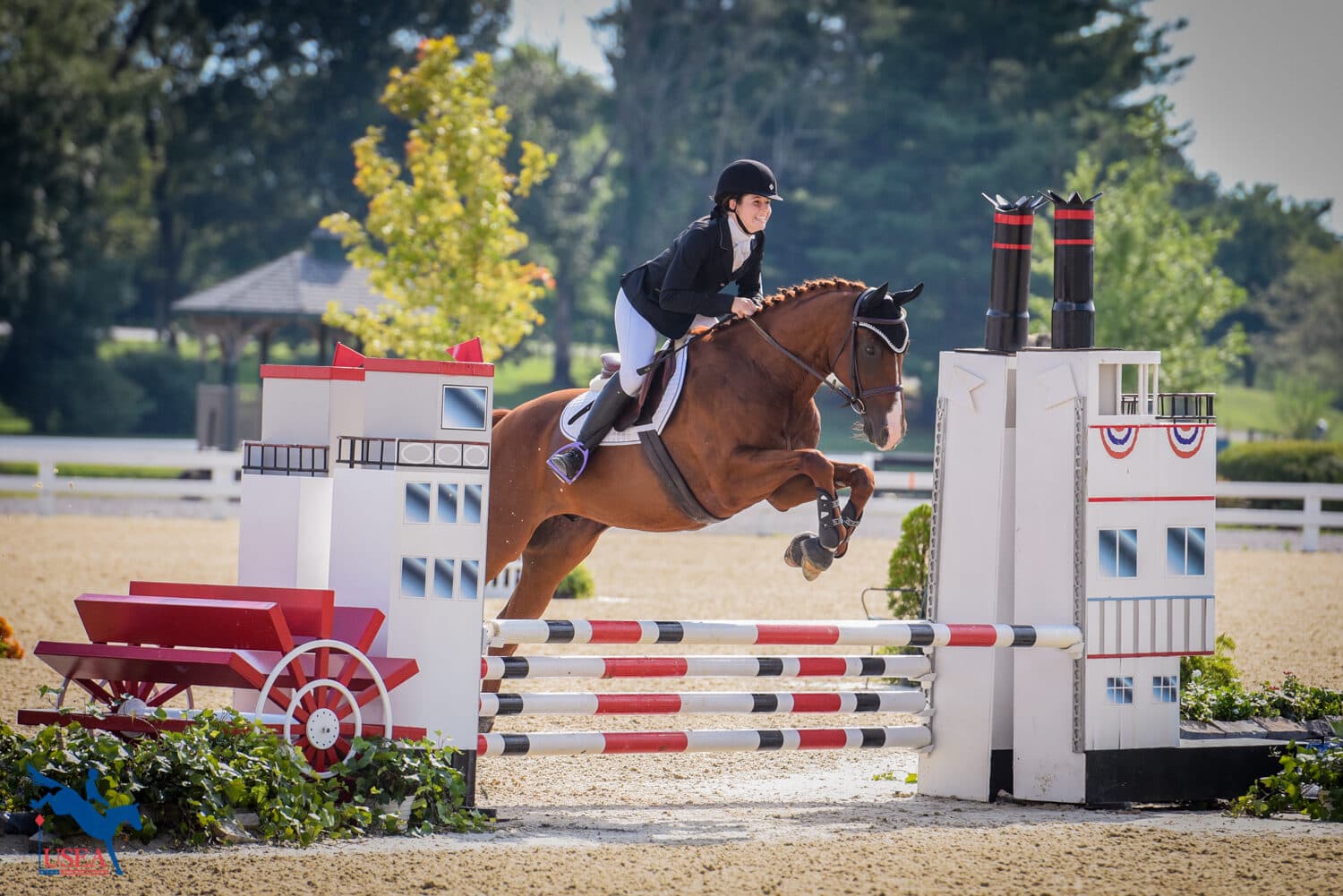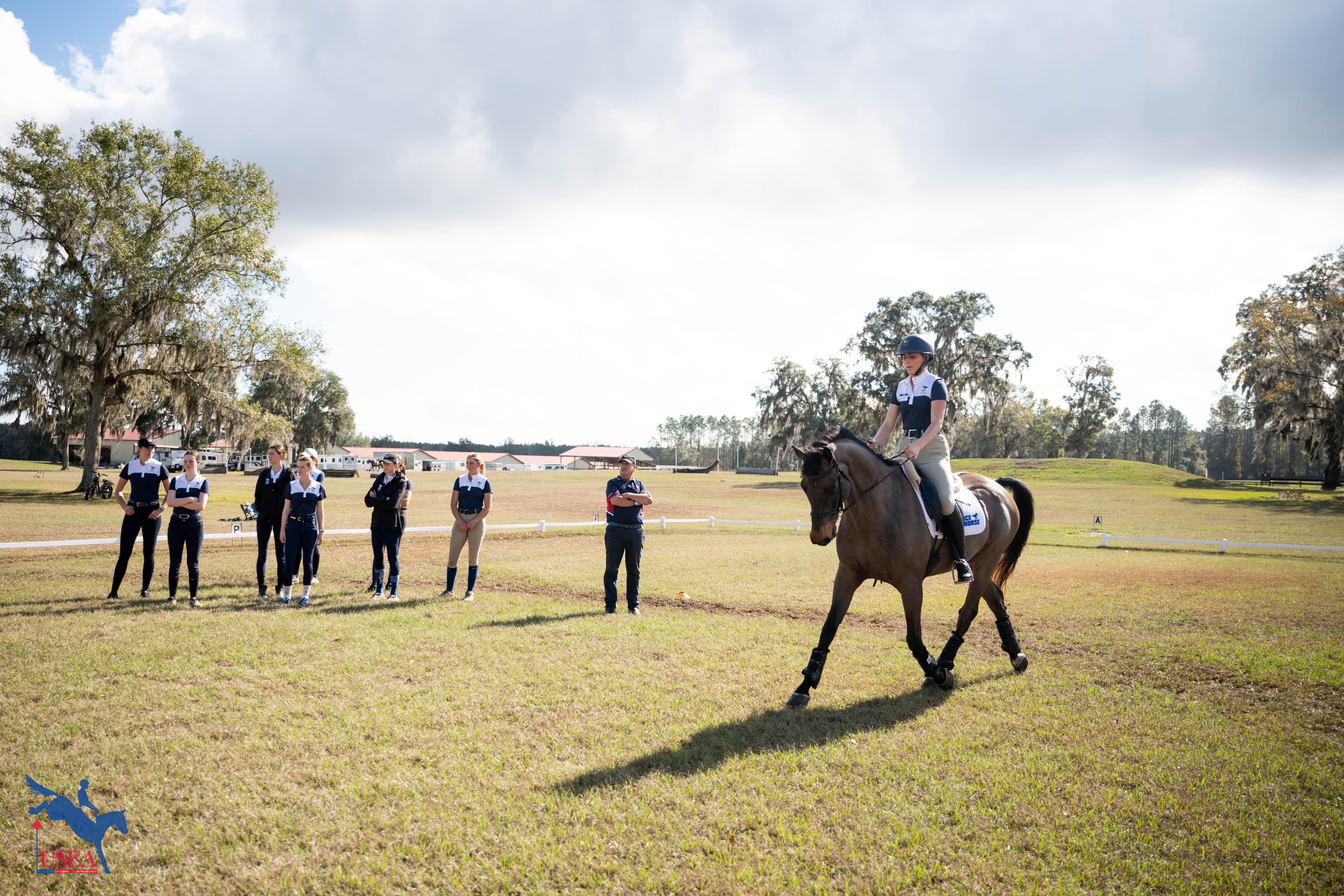Rule Refresher: Show Jumping Penalties

What are the different ways to incur penalties during a show jumping round? From knocking down a fence to refusals and run-outs and even unauthorized assistance, it is important to know the different ways you can accrue faults in the show jumping arena.
Text has been taken directly from the USEF Rules for Eventing with emphasis added by the USEA.
EV150 Penalties
1. During a round, penalties are incurred for:
a. Knocking down an obstacle (EV150.2)
b. A disobedience (EV150.4);
c. A deviation from the course (EV150.5);
d. A fall of a horse and/or competitor (EV150.9);
e. Unauthorized assistance (EV151);
f. Exceeding the time allowed or the time limit (EV152.2 and .3).
2. KNOCK DOWN
a. An obstacle is considered to have been knocked down when, through a mistake of the horse or competitor:
1. The whole or any upper part of the same vertical plane of it falls, even if the part which falls is arrested in its fall by any other part of the obstacle (EV150.3).
2. At least one of its ends no longer rests on any part of its support.
b. Touches and displacements of any part of an obstacle or its flags, in whatever direction, while in the act of jumping, do not count as a knock down. If in doubt the Ground Jury should decide in favor of the competitor. The knock down or displacement of an obstacle as a result of a disobedience is penalized as a refusal only. In the event of the displacement of any part of an obstacle, (except the flags), as a result of a disobedience, the bell will be rung and the clock stopped while the displacement is re-adjusted. This does not count as a knock down and is only penalized as a disobedience and corrected by time in accordance with article EV152.8.
c. If any part of an obstacle, which has been knocked down is likely to impede a competitor in jumping another obstacle, the bell must be rung and the clock stopped while this part is picked up and the way is cleared.
d. If a competitor jumps an obstacle correctly which has been improperly rebuilt, he incurs no penalty; but if he knocks down this obstacle he will be penalized.
3. VERTICAL AND SPREAD OBSTACLES
a. When a vertical obstacle or part of an obstacle comprises two or several parts placed one above the other and positioned in the same vertical plane, only the fall of the top part is penalized. (EV149.8)
b. When a spread obstacle which requires only one effort comprises parts which are not positioned in the same vertical plane, the fall of one or several top parts only counts as one fault whatever the number and position of the parts which have fallen. Trees, hedges etc. used as filling are not liable for penalties.
4. DISOBEDIENCES
a. The following are considered as disobediences and are penalized as such (EV153):
1. a refusal;
2. a run-out;
3. a resistance;
4. a more or less regular circle or group of circles no matter where they occur on the course or for whatever reason. It is also a disobedience to circle around the last obstacle jumped unless the track of the course so requires.
b. Notwithstanding the above, it is not considered to be a disobedience to circle for up to 45 seconds after a run-out or a refusal (no matter if the obstacle has to be rebuilt or not) to get into position to jump an obstacle;
5. DEVIATION FROM THE COURSE
a. It is a deviation from the course when the competitor:
1. does not follow the course as set out on the published plan;
2. does not cross the starting line or the finishing line between the flags in the correct direction (EV154.2p and EV154.2f);
3. does not jump the obstacles in the order or in the direction indicated,
4. jumps or attempts to jump an obstacle which does not form part of the course or omits an obstacle. Obstacles not included in the course should be crossed but failure to do so by the arena party will not preclude the elimination of a competitor for jumping an obstacle not forming part of the course.
b. An uncorrected deviation from the course incurs elimination (EV154.2 f.-j. and EV154.2p)
6. REFUSAL
a. It is a refusal when a horse halts in front of an obstacle, which it must jump whether or not the horse knocks it down or displaces it.
b. Stopping in front of an obstacle without moving backwards and without knocking it down followed immediately by a standing jump is not penalized.
c. If the halt is prolonged, if the horse steps back, either voluntarily or not, even a single pace, it counts as a refusal.
d. If a horse slides through an obstacle, the Judge in charge of the bell must decide immediately if it is to count as a refusal or as an obstacle knocked down. If he decides that it is a refusal the bell is rung at once and the competitor must be ready to attempt the obstacle again as soon as it has been rebuilt (EV152.8 and EV152.9)
1. If the Judge decides that it is not a refusal, the bell is not rung and the competitor must continue his round. He is then penalized as for an obstacle knocked down.
2. If the bell has been rung and the competitor jumps other elements of the combination in his stride, it does not entail elimination or any further penalty should he knock down this element of the combination.
7. RUN-OUT
a. It is a run-out when the horse escapes the control of its competitor and avoids an obstacle, which it has to jump.
b. When a horse jumps an obstacle between two red flags or between two white flags the obstacle has not been jumped correctly, the competitor is penalized as for a run-out and he must jump the obstacle again correctly.
c. It is considered to be a run out and is penalized as such for a horse or any part of a horse to go past the extended line of an obstacle to be jumped, or of an element of a combination, or of the finishing line
8. RESISTANCE
a. It is a resistance when the horse refuses to go forward, makes a halt for any reason, makes one or several more or less regular or complete half turns, rears or steps back for whatever reason.
b. It is equally a resistance when the competitor stops his horse at any moment and for any reason, except in the event of an incorrectly rebuilt obstacle or to indicate unforeseen circumstances to the Ground Jury (EV152.9c(2)). A resistance is penalized as for a refusal except in the circumstances set out in rule EV154.3c.
9. FALLS
a. A competitor is considered to have fallen when, either voluntarily or involuntarily, he is separated from his horse, which has not fallen, in such a way that he touches the ground or finds it necessary, in order to get back into the saddle, to use some form of support or outside assistance. If it is not clear that the competitor has used some form of support or outside assistance to prevent his fall, the benefit of doubt must be given to the competitor.
b. A horse is considered to have fallen when the shoulder and quarters have touched the ground or the obstacle and the ground.
EV151 Unauthorized Assistance
1. Any intervention by a third party between the crossing of the starting line in the correct direction and the crossing of the finishing line after jumping the last obstacle, whether solicited or not, with the object of helping the competitor or his horse is considered to be unauthorized assistance.
2. Any form of unauthorized assistance received by a mounted competitor between the starting line and the finishing line will penalized by elimination at the discretion of the Ground Jury.
a. In certain exceptional cases, the Ground Jury may authorized the competitor to enter the arena on foot or with the help of a groom without this being considered as unauthorized assistance.
b. Any help given to a mounted competitor to adjust his saddlery or bridle or to hand him a whip while mounted during the round will incur elimination. To hand a mounted competitor his headgear and/or spectacles during his round is not considered to be unauthorized assistance (EV154.2s)
c. The act of officials or other persons of warning a competitor of a deviation from the course constitutes unauthorized assistance. In this event the competitor may be eliminated at the discretion of the Ground Jury and the official or other persons may be subject to a penalty at the discretion of the Ground Jury.
Want to catch up on past rule refreshers? Click here.














